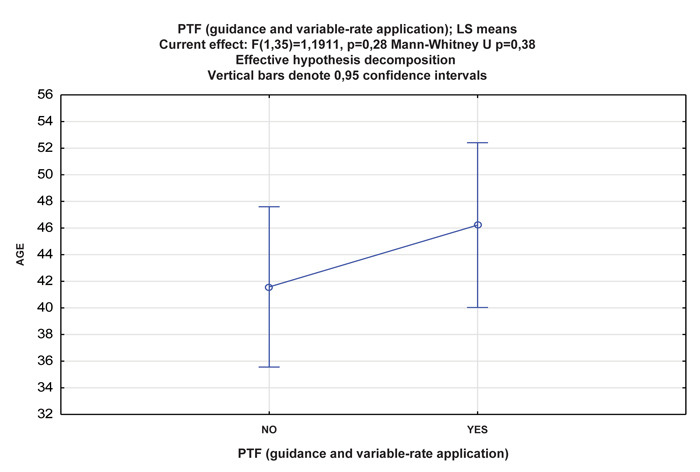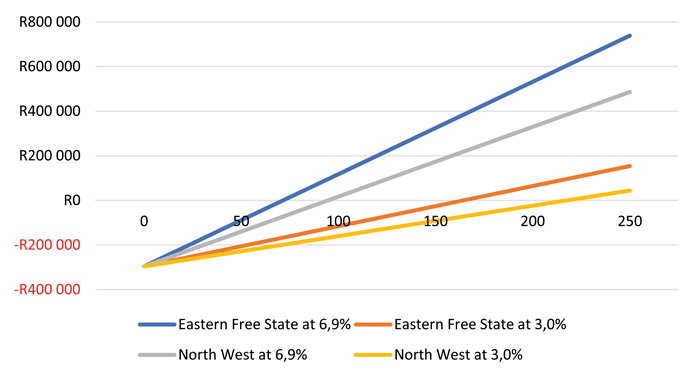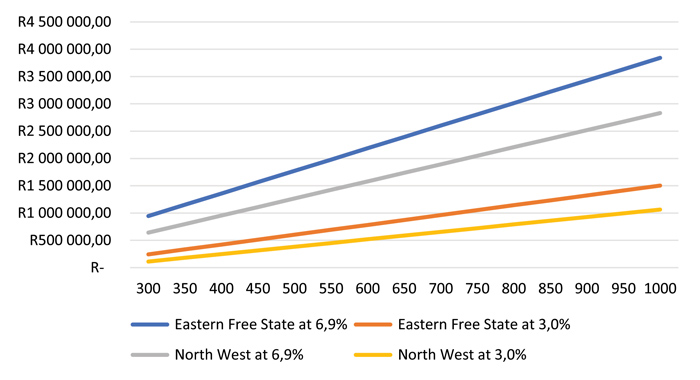
The incessant cost-price squeeze which forces producers to continually increase their productivity and reduce input costs, has prompted the author to research current adoption rates, farm-level barriers and perceived benefits of precision agriculture technology.
Surveys were distributed among 37 producers and across five provinces. The data was collected in a variety of ways, including interviews, email responses and online surveys. In the sample, adoption rates were found to be 65% for guidance, 51% for section control and 49% for variable-rate application. This compares favourably to the international literature, which estimates the aggregate adoption of these technologies at between 29% for variable-rate application and 59% for guidance in maize production.
Results of the study
However, the South African adoption rates still leave ample room for improvement, especially amongst smaller farms which were underrepresented in this study. It was found that producers who use precision farming technology believe that the technology has clear benefits with respect to increasing productivity and efficiency. Concerning the producers who do not use precision agriculture technology, responses were mixed, creating the impression that this subset of producers is unclear about the extent of the benefits and for some producers the suitability of the technology, given the computer literacy of their operators.
Barriers
The barriers to the adoption of precision agriculture technology are often considered to be age and education. This was not prevalent in the study as producers who adopted precision agriculture technology had a higher mean age than those producers who did not use any form of precision agriculture technology as seen in Figure 1. More significant barriers revolved around agronomic factors, including the use and understanding of the information behind these precision agriculture systems.

Variable-rate application
In terms of variable-rate application (VRA), 56% of producers that do not use VRA, agreed that it would help their farm management. A further 83% agreed that it would increase in-field speed and thus result in greater productivity. Mixed results were obtained from questions where producers did not have sufficient knowledge and/or experience with precision agriculture, as shown with the results on the execution of prescription maps, generation of prescription maps and other activities relating to data management.
Concerning adopting precision agriculture technology over the short to medium term, 68% of producers who do not utilise precision agriculture technology agreed that they intended to equip their machinery with such technology with section control, VRA or guidance during their next machinery replacement cycle. Thus, there is a trend towards the greater adoption of precision agriculture in the short- to medium-term future.
Producers’ perceptions
Producers that use precision agriculture technology see clear benefits in improved yield, decreased yield variability, efficient input and resource allocation, improved in-field speed and productivity. Research was conducted into whether producers have the perception that precision agriculture technology influences the quality of grain produced. This question had an intriguing response with 46% of producers agreeing that precision agriculture does improve grain quality.
Average perceived increase in yield from the use of precision agriculture was 6,9%. This 6,9% increase in yield will take the average yield in the 2018 season from 5,50 t/ha in the Eastern Free State to 5,88 t/ha. The additional 380 kg of maize produced will result in an R827,69 increase in gross income per hectare. This increase per year will result in the break-even point of one full precision agriculture package (VRA, section control and auto-steer) at 80 ha of maize production in the Eastern Free State, depreciated over five years. Similarly, in the North West Province, a 6,9% increase in yield results in an increase from 4,25 t/ha to 4,54 t/ha. The extra 290 kg will result in an R618,57 increase in gross income per hectare. The break-even point for one full precision agriculture GPS system is 100 ha of maize production per annum, depreciated over five years. GPS pricing for a system was taken at an average across multiple providers for a system that can execute VRA, section control and auto-steer, including the unlock keys for the latter. However, this does not include the yearly subscription.
Break-even calculation
The break-even calculation mentioned above focusses on the production of maize without factoring in any other on-farm expenses which can take priority. Graph 1 illustrates the net profit from the perceived benefits of using precision agriculture technology over five years on up to 250 ha. Graph 1 illustrates the break-even point of a single GPS system with the capability and unlock key for VRA as well as section control. From Graph 1, it can be seen that the break-even point in terms of annual hectares planted correlated to around 80 ha in the Eastern Free State at an increase in yield of 6,9%. An increase in yield of 3% in the Eastern Free State correlates to a break-even point of around 160 ha planted annually. In the North West Province, an increase in yield at 6,9% correlates to a break-even point in terms of hectares planted at 100 ha, while a 3% increase in yield results in a break-even point of 225 ha. Graph 2 is an extension of Graph 1. However, it extends further and illustrates the net profit through to a 1 000-ha production system.


Policies related to precision agriculture
There is always scope for policy improvement in the agriculture sector, especially concerning how food is produced for the country. VRA does not only allow for the efficient allocation of input resources, but also reduces the environmental impact of these resources. This is done by applying the correct quantity of seed, fertiliser and chemicals to a specific soil type, soil depth and soil potential across a single field.
Single rate application can often over-apply fertiliser and chemicals to a specific area of the field as the single rate refers to the average soil conditions of the field and not the specific conditions within the field. With a single rate application, there is often leaching of chemicals and fertilisers, which can be degrading to the environment if not applied correctly. It would therefore be beneficial for the Department of Agriculture, Land Reform and Rural Development (DALRRD) to implement a subsidy or incentive for producers practising VRA as well as contractors providing the opportunity for small farmers to execute VRA without having to purchase the technology themselves.
There is also scope for the implementation of a subsidy regarding the other forms of precision agriculture technology, where not only inputs are perceived to be used more efficiently, but also fuel. If producers are using fuel more efficiently, it will have a reduced impact on carbon dioxide emissions and be sustainable for the environment. It will therefore be beneficial for the DALRRD to implement a subsidy or incentive program for the use of section control and guidance and not only VRA.
A possible policy for the support concerning the adoption of precision agriculture technology could allow the DALRRD to sponsor training programs for operators on farms to enable them to obtain an education on the systems and their usability. This will help reduce the barrier of operator literacy with regards to precision agriculture technology.



























